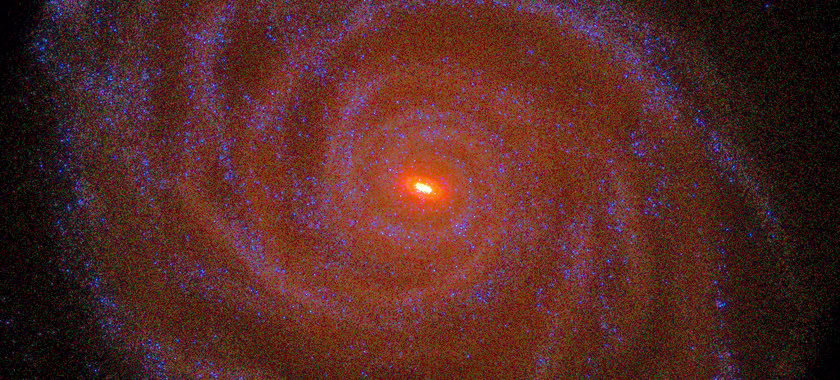Science
Researchers Unveil Dark Matter’s Role in Milky Way’s Gamma-Ray Glow

Astronomers have made significant strides in understanding the mysterious high-energy gamma radiation emanating from the centre of the Milky Way galaxy. A team led by researchers at the Leibniz Institute for Astrophysics Potsdam (AIP) proposes that a flattened distribution of dark matter, rather than a spherical one, could explain the properties of this enigmatic glow. This research brings scientists closer to solving one of the universe’s enduring mysteries.
Dark matter, which is believed to comprise more than 25% of the universe’s total mass, does not emit or absorb light, making it challenging to study directly. Instead, it is detected primarily through its gravitational effects on visible matter. Despite the wealth of astrophysical and cosmological evidence supporting its existence, the true nature of dark matter remains elusive.
Joseph Silk, an astronomer at Johns Hopkins University in the United States and the Institut d’Astrophysique de Paris, co-led this research alongside AIP’s Moorits Mihkel Muru. Silk noted, “Gamma rays, and specifically the excess light we’re observing at the centre of our galaxy, could be our first clue” in identifying dark matter.
Muru emphasized that previous models used to explain the excess gamma-ray radiation were overly simplistic. “We showed that in this case, the details are important: we can’t model dark matter as a perfectly symmetrical cloud,” he explained. The researchers argue that understanding the asymmetrical nature of dark matter is crucial for accurately interpreting the gamma-ray emissions.
The findings, published in Physical Review Letters, lend support to the “dark matter annihilation” hypothesis, which posits that in regions of high dark matter density, particles could annihilate each other, producing significant radiation. This concept aligns with the standard model of cosmology, which suggests that all galaxies, including the Milky Way, are enveloped in massive haloes of dark matter.
According to Pierre Salati, an emeritus professor at Université Savoie Mont Blanc, the annihilation of dark matter could be essential for generating a component that aligns with cosmological observations. He noted that despite stringent constraints set by Big Bang nucleosynthesis, many models still survive scrutiny. “One of the most exciting aspects of such explanations is that dark matter species might be detected through the rare antimatter particles they produce,” Salati added.
While the research presents intriguing possibilities, some experts urge caution. Silvia Manconi of the Laboratoire de Physique Théorique et Hautes Energies in France remarked that the complexity of reality may exceed even advanced simulations. She acknowledged that this is not the first study to explore non-spherical shapes in galaxy simulations but noted that the new work offers significant improvements in spatial resolution.
Manconi also pointed out that the study does not clarify how the proposed distribution of dark matter would appear in data from the Fermi Gamma-ray Space Telescope or how it would quantitatively differ from observations of older star distributions. Future observations with radio telescopes such as MeerKAT and FAST may soon reveal pulsars in this region, potentially providing further insight into the gamma-ray excess.
Muru recognizes that additional modeling and observational data are necessary to eliminate competing hypotheses. “Studying dark matter is very difficult because it doesn’t emit or block light, and despite decades of searching, no experiment has yet detected dark matter particles directly,” he stated.
The potential confirmation of dark matter annihilation as the source of the observed excess radiation would represent a significant leap forward in astrophysics. Muru highlighted that new gamma-ray telescopes, such as the Cherenkov Telescope Array, currently under construction, could further illuminate this mystery. “If these telescopes fail to find star-like sources for the glow and only detect diffuse radiation, that would strengthen the alternative dark matter annihilation explanation,” he noted.
As researchers continue to explore the cosmos, the quest to understand dark matter remains a priority. “It’s possible we will see the new data and confirm one theory over the other,” Silk said, leaving open the thrilling possibility that the universe still holds many secrets waiting to be uncovered.
-

 Entertainment3 months ago
Entertainment3 months agoAnn Ming Reflects on ITV’s ‘I Fought the Law’ Drama
-

 Entertainment4 months ago
Entertainment4 months agoKate Garraway Sells £2 Million Home Amid Financial Struggles
-

 Health3 months ago
Health3 months agoKatie Price Faces New Health Concerns After Cancer Symptoms Resurface
-

 Entertainment3 months ago
Entertainment3 months agoCoronation Street’s Carl Webster Faces Trouble with New Affairs
-

 Entertainment3 months ago
Entertainment3 months agoWhere is Tinder Swindler Simon Leviev? Latest Updates Revealed
-

 Entertainment4 months ago
Entertainment4 months agoMarkiplier Addresses AI Controversy During Livestream Response
-

 Science1 month ago
Science1 month agoBrian Cox Addresses Claims of Alien Probe in 3I/ATLAS Discovery
-

 Entertainment4 months ago
Entertainment4 months agoKim Cattrall Posts Cryptic Message After HBO’s Sequel Cancellation
-

 Entertainment2 months ago
Entertainment2 months agoOlivia Attwood Opens Up About Fallout with Former Best Friend
-

 Entertainment3 months ago
Entertainment3 months agoMasterChef Faces Turmoil as Tom Kerridge Withdraws from Hosting Role
-

 Entertainment4 months ago
Entertainment4 months agoSpeculation Surrounds Home and Away as Cast Departures Mount
-

 World3 months ago
World3 months agoCole Palmer’s Mysterious Message to Kobbie Mainoo Sparks Speculation





















